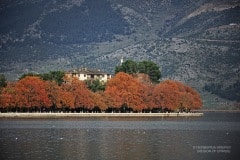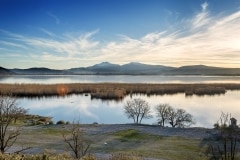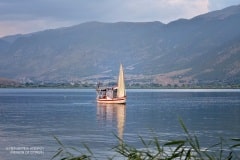
Lake Pamvotis & Nisaki
Pamvotis (“the all-nourishing”) is the ancient name of the celebrated lake of Ioannina, which adorns the city with its exquisite beauty. The lake of Ioannina entices visitors with its rich history, embellished with centuries-old legends and traditions. Formed around seven million years ago, it is considered one of the oldest lakes in the world and the second oldest in Europe after lake Ohrid.
Its length is 7.5 km, its maximum width 5 km, its depth 11 m, and it has a total surface of 23 sq. km. It is a sensitive ecosystem that belongs to the European Natura 2000 Protected Areas Network. To the north, Mount Mitsikeli is reflected in its idle waters, and to the south you can see the eastern slopes of Mount Tomaros. The lake is supplied by the three springs of Mount Mitsikeli (Drabandova, Sentenikos and Krya). The lake of legends and traditions has been associated with the story of Kyra Frosini, the beautiful noblewoman from Ioannina, who was drowned in its waters along with 16 other women by Ali Pasha, another legendary figure of Ioannina, in January 1801. In the mornings when the mist hides its beauty, a melancholic yet always impressive setting is created! The lake shores are covered with dense reed beds, and the vegetation includes forests of willows, poplars, maple trees, plane trees and wet meadows where many species of birds find shelter. The avifauna of the region includes more than 170 species. The lake is home to 9 of amphibians species, 24 species of reptiles and 24 species of fish, the most well-known being eels, common carps, grass carps and sheatfish.
To the northwest of Lake Pamvotida, lies the beautiful Nisaki, one of the few inhabited lake islands in Europe, which, among other things, is the only one in the world without a name! For most people, it is Lake Island or Kyra Frosini Island. It is a small natural wonder of incredible beauty and historical importance. The island is associated with the life and death of Ali Pasha. The settlement of the island, where approximately 210 people, mainly fishermen, permanently reside, is built according to the local Epirotic architecture with traditional houses, beautiful gardens and narrow cobbled streets. According to tradition, the first people to settle on the island in the 17th century were from Mani, although organized living on the island has existed since the Byzantine and post-Byzantine periods.
The western part of the island has a mild coast, while the rest is rocky, with impressive rock outcrops in the water. This small paradise was once a great monastic center and today, seven monasteries of high historical value are preserved on the island. The most important is the Monastery of Philanthropinos. The 16th century frescoes in the Monastery are the most remarkable post-Byzantine frescoes in Epirus, with the most exceptional one depicting the 7 sages of antiquity. The Monastery of Agios Panteleimon became widely known due to the events of 1822, when the Sultan’s troops besieged and assassinated Ali Pasha. Today, the Pre-Revolutionary Period Museum is housed in its southern cells.
Ferries connect the city of Ioannina with the island and routes are executed every half hour from early morning until late at night and thousands of people visit it every year.




